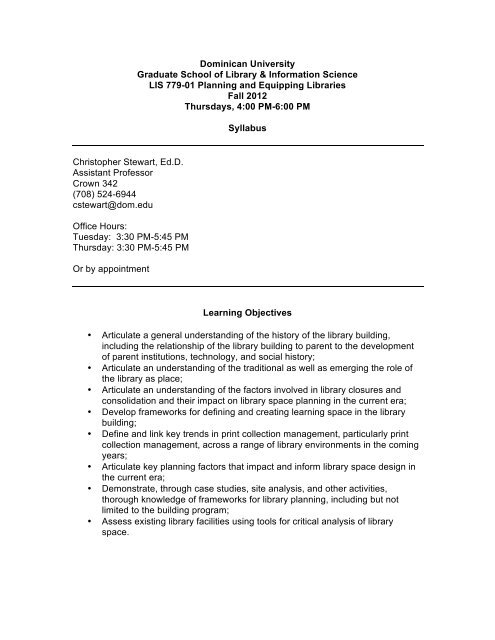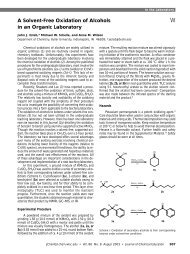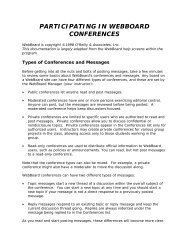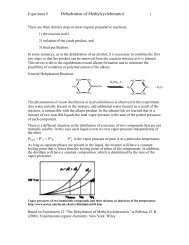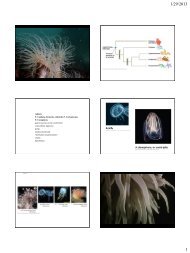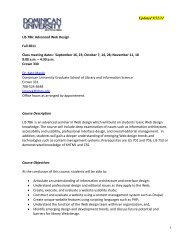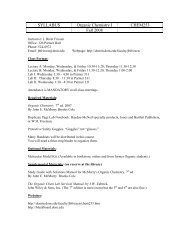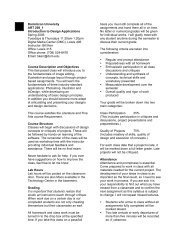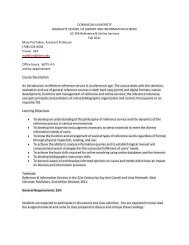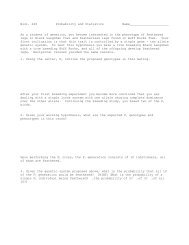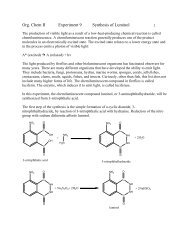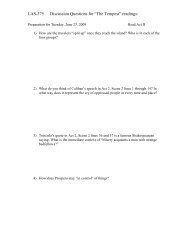Planning and Equipping Libraries - Dominican University
Planning and Equipping Libraries - Dominican University
Planning and Equipping Libraries - Dominican University
You also want an ePaper? Increase the reach of your titles
YUMPU automatically turns print PDFs into web optimized ePapers that Google loves.
<strong>Dominican</strong> <strong>University</strong>Graduate School of Library & Information ScienceLIS 779-01 <strong>Planning</strong> <strong>and</strong> <strong>Equipping</strong> <strong>Libraries</strong>Fall 2012Thursdays, 4:00 PM-6:00 PMSyllabusChristopher Stewart, Ed.D.Assistant ProfessorCrown 342(708) 524-6944cstewart@dom.eduOffice Hours:Tuesday: 3:30 PM-5:45 PMThursday: 3:30 PM-5:45 PMOr by appointmentLearning Objectives• Articulate a general underst<strong>and</strong>ing of the history of the library building,including the relationship of the library building to parent to the developmentof parent institutions, technology, <strong>and</strong> social history;• Articulate an underst<strong>and</strong>ing of the traditional as well as emerging the role ofthe library as place;• Articulate an underst<strong>and</strong>ing of the factors involved in library closures <strong>and</strong>consolidation <strong>and</strong> their impact on library space planning in the current era;• Develop frameworks for defining <strong>and</strong> creating learning space in the librarybuilding;• Define <strong>and</strong> link key trends in print collection management, particularly printcollection management, across a range of library environments in the comingyears;• Articulate key planning factors that impact <strong>and</strong> inform library space design inthe current era;• Demonstrate, through case studies, site analysis, <strong>and</strong> other activities,thorough knowledge of frameworks for library planning, including but notlimited to the building program;• Assess existing library facilities using tools for critical analysis of libraryspace.
Relevant MLIS Program Objectives• Underst<strong>and</strong> the essential nature of information <strong>and</strong> its relevance to society• Assess community information needs <strong>and</strong> interests• Develop appropriate responses to information needs• Synthesize theory <strong>and</strong> practice within a dynamic <strong>and</strong> evolving informationenvironment• Articulate theories <strong>and</strong> concepts in relation to professional practice• Demonstrate application of theory to practiceRequired MaterialsThere are no required texts for this course. The readings will be drawn from a widerange of print <strong>and</strong> digital/web-based resources on library planning <strong>and</strong>design. Resources will be made available to you via the library course site, books onreserve at Crown Library, <strong>and</strong>, in some cases, materials distributed in class.Course ApproachTeaching strategies will include assigned readings, lectures, group discussion <strong>and</strong> caseanalysis, <strong>and</strong> papers <strong>and</strong> presentations. Theoretical concepts <strong>and</strong> practicalapplications typically will be presented through class lecture, assigned readings, <strong>and</strong>site visits. Students will demonstrate their underst<strong>and</strong>ing through class discussions,written work, evaluating current literature, <strong>and</strong> working in teams. It is therefore expectedthat students will not only read the assignments, cases, <strong>and</strong> other material, but alsothoughtfully evaluate the material.Grading CriteriaThe following grades <strong>and</strong> their grade point equivalents for the <strong>Dominican</strong> <strong>University</strong>Graduate Schools are:AlphaGradeNumericalEquivalentPointSpanA 4.0 100 - 95A- 3.67 94 - 90B+ 3.33 89 - 85B 3.0 84 - 80B- 2.67 79 - 75C+ 2.33 74 - 70C 2.0 69 - 65C- 1.67 64 <strong>and</strong>belowThe faculty of the Graduate School of Library <strong>and</strong> Information Science use the followingguidelines in their grading:
Outst<strong>and</strong>ing achievement (A/4.0). Student performance demonstrates full comm<strong>and</strong>of the course materials <strong>and</strong> evinces a high level of originality <strong>and</strong>/or creativity thatfar surpasses course expectations; nearly flawless work.Excellent achievement (A-/3.67). Student performance demonstratesthorough knowledge of the course materials <strong>and</strong> exceeds course expectationsby completing all requirements in a superior manner.Good solid work (B+/3.33). Student performance demonstrates strong comprehensionof the course materials <strong>and</strong> exceed course expectations on all tasks as defined in thecourse syllabus.Satisfactory acceptable work (B/3.0). Student performance meets designated courseexpectations, demonstrates underst<strong>and</strong>ing of the course materials <strong>and</strong> performs atan acceptable level.Marginal work (B-/2.67). Student performance demonstrates incomplete,subst<strong>and</strong>ard underst<strong>and</strong>ing of course materials, or absence of required work;indicates danger of falling below acceptable grading st<strong>and</strong>ard.Unsatisfactory work (C+/2.33). Student performance demonstratesunsatisfactory underst<strong>and</strong>ing of course materials <strong>and</strong> inability to meet courserequirements.Unacceptable work (C/2.0). Student performance demonstrates incomplete<strong>and</strong> inadequate underst<strong>and</strong>ing of course materials.Poor work (C-1.67).Failing grade (F).Academic Integrity(http://www.dom.edu/library/help/academic-integrity)Students of the university must conduct themselves in accordance with the highestst<strong>and</strong>ards of academic honesty <strong>and</strong> integrity. Failure to maintain academic integrity willnot be tolerated. The following definitions are provided for underst<strong>and</strong>ing <strong>and</strong> clarity.Definitions of Plagiarism, Cheating <strong>and</strong> Academic DishonestyStudent plagiarism is the deliberate presentation of the writing or thinking of another asthe student’s own. In written or oral work a student may make fair use of quotations,ideas, images, etc., that appear in others’ work only if the student gives appropriatecredit to the original authors, thinkers, owners or creators of that work. This includesmaterial found on the Internet <strong>and</strong> in electronic databases. Cheating entails the use ofunauthorized or prohibited aids in accomplishing assigned academic tasks. Obtainingunauthorized help on examinations, using prohibited notes on closed-noteexaminations, <strong>and</strong> depending on others for the writing of essays or the creation of otherassigned work are all forms of cheating.Academic dishonesty may also include other acts intended to misrepresent theauthorship of academic work or to undermine the integrity of the classroom or of gradesassigned for academic work. Deliberate acts threatening the integrity of library materialsor the smooth operation of laboratories are among possible acts of academic
dishonesty.Sanctions for Violations of Academic IntegrityStudents caught plagiarizing, cheating, or committing other acts of academic dishonestywill receive an automatic failure for the assignment, exam or paper. When a sanctionhas been imposed, the instructor will inform the student in writing.When a sanction is imposed, the instructor will send written notification to the dean ofthe Graduate School of Library <strong>and</strong> Information Science. The dean will note whether astudent has a pattern of committing violations of the academic integrity policy over time,<strong>and</strong> in such cases the dean may impose further sanctions, including suspension orexpulsion from the universityThe instructor must also inform the student that she/he has the right to appeal thissanction, <strong>and</strong> refer the student to the academic appeals process described below.Graduate Student Academic Grievance ProcessDecisions concerning graduate education issues at <strong>Dominican</strong> <strong>University</strong> are based onpolicies approved by the <strong>Dominican</strong> <strong>University</strong> Graduate Committee (“GC”). Studentswho consider that they have been treated unfairly in the situations specificallymentioned above may consider the following course of action in order:1. Confer, first, with the faculty member responsible for the decision.2. If the grievance remains unresolved after step 1 above, confer with the Dean of theGraduate School of Library <strong>and</strong> Information Science. Present a written narrativeexplanation of the grievance.3. If unresolved, the Dean will appoint an ad-hoc committee to hear the case.Students wishing to file an appeal must do so no later than the end of the subsequentsemesters add/drop date.
Course Calendar on Next Page
Course CalendarAugust 30First half: Course <strong>and</strong> student introductions. Discussion of student expectations for theclass. Overview of projects.Second half: Group assignment/discussion: Do we still need library buildings? Why?September 6Site <strong>and</strong> Sanctuary: a Brief History of the Library BuildingReadings:Carnegie: <strong>Libraries</strong>’ Master Builder. (1996).Library Journal, 60.Edwards, B., & Fisher, B. (2002). <strong>Libraries</strong> <strong>and</strong> Learning Resource Centers. Oxford:Architectural Press. Ch. 1LIBRARIES. (2000). In Encyclopedia of the United States in the Nineteenth Century.Retrieved from http://www.credoreference.com.ezproxy.dom.edu/entry/galeus/librariesKhan, A. (2009). Better by Design: an Introduction to <strong>Planning</strong> <strong>and</strong> Designing a NewLibrary Building. London: Facet Publishing. Ch. 2Rizzo, J. C. (1996). Carneigie Legacy: Preserving the Past While Looking into theFuture. American <strong>Libraries</strong>, 27, 58–60.Second half: Learning about Library Building Projects: Research Tools for ExploringMulti-type Data on Contemporary Library Construction <strong>and</strong> Renovation ActivityReadings (familiarize yourself with all of these resources):L<strong>and</strong>graf, G. (2012). New & Now. American <strong>Libraries</strong>, 43(3/4), 28–35Library Journal; Fall2011 Library By Design Supplemt, (read all project summaries <strong>and</strong>construction activity report)Designing <strong>Libraries</strong> - A database <strong>and</strong> image gallery of library buildings.http://www.designinglibraries.org.uk/index.asp?PageID=15 (NOTE: primarily UKlibraries)Campus Architecture Database. http://chronicle.com/blogs/buildings/campusarchitecture-database-alan-b-miller-hall/26130
School Designs Home Page. (n.d.). Retrieved August 21, 2012, fromhttp://schooldesigns.comSeptember 13The Library as Place <strong>and</strong> Other Themes for the 21 st Century Library BuildingReadings:Fialkoff, F. (2010). Third Place or Thinking Space. Library Journal. Retrieved fromhttp://www.libraryjournal.com/article/CA6716262.htmlFreeman, G. (2005). The library as place: Changes in learning pattern, collections,technology, <strong>and</strong> use. Library as place: Rethinking roles, rethinking space (pp. 1–10).Washington, D.C: Council on Library <strong>and</strong> Information Resources. Retrieved fromhttp://www.clir.org/pubs/reports/pub129/pub129.pdfJohnson, D. (2011). School <strong>Libraries</strong> as a “Third Place.” Library Media Connection,29(1), 106.F. Kent, & Myrick, P. (n.d.). How to become a great public space. American <strong>Libraries</strong>,34(4), 72–76.Mattern, S. (n.d.). Little <strong>Libraries</strong> <strong>and</strong> Tactical Urbanism: Places: Design Observer.Retrieved from http://places.designobserver.com/feature/little-libraries-<strong>and</strong>-tacticalurbanism/33968/Oldenburg, R. (1999).The Great Good Place: Cafes, Coffee Shops, Bookstores, Bars, Hair Salons, <strong>and</strong> OtherHangouts at the Heart of a Community (3 rd ed.). Marlowe & Company. (Ch. 2)Scott, M. (n.d.). How <strong>Libraries</strong> <strong>and</strong> Bookstores Became the New Community Centers |Newgeography.com. Retrieved from http://www.newgeography.com/content/002629-how-libraries-<strong>and</strong>-bookstores-became-new-community-centersStudent presentations/case studies highlighting recent library construction <strong>and</strong>renovation projectsSeptember 20The Long Good-bye? Investigating Impact of Library Closures <strong>and</strong> Consolidations onUsage <strong>and</strong> Design on Space in the Current Era.
Readings:Bell, S. (n.d.). It Was Nice Knowin’ Ya, Special Branch Library | From the Bell Tower.http://www.libraryjournal.com/article/CA6703290.htmlCarlson, S. (n.d.). The Deserted Library. Chronicle of Higher Education, 48(12), A35.Byrnes, B. (2009, May 13). <strong>Libraries</strong> lost to budget cuts | The Daily. Retrieved fromhttp://dailyuw.com/news/2009/may/13/libraries-lost-to-budget-cuts/Goldberg, L. (2011, February 25). Evanston Says Farewell To South Branch Library -Evanston, IL Patch. Retrieved from http://evanston.patch.com/articles/evanston-saysfarewell-to-south-branch-libraryKoontz, C. M., Jue, D. K., & Bishop, B. W. (2009). Public library facility closure: Aninvestigation of reasons for closure <strong>and</strong> effects on geographic market areas. Library &Information Science Research (07408188), 31(2), 84–91.Weinstock, S. Y., & Worl<strong>and</strong>, J. C. (n.d.). The Sun Sets on the Traditional Library. TheHarvard Crimson. Retrieved from http://www.thecrimson.com/article/2012/5/24/librariesdigitize-centralize-staff/September 27Partial Print? Post-Print? No Print? The Future of Print <strong>and</strong> Implications for LibrarySpace DesignReadings:A Library Designed for the Post-Print Era | Co.Design: business + innovation + design.(n.d.). Retrieved from http://www.fastcodesign.com/1662561/a-library-designed-for-thepost-print-eraLatimer, K. (2011). Collections to Connections: Changing Spaces <strong>and</strong> New Challengesin Academic Library Buidlings. Library Trends, 60(1), 112–133.Lewis, D. (n.d.). From Stacks to the Web: the Transformation of Academic LibraryCollecting. College & Research <strong>Libraries</strong>, 74(1). Retrieved fromhttp://crl.acrl.org/content/early/2012/01/09/crl-309.shortMason, C. (2011, August 25). New schools are shelving the old library. Seattle DailyJournal of Commerce. Retrieved fromhttp://www.djc.com/news/co/12032455.html Report of the Collection DevelopmentExecutive Committee Task Force on Print Collection Usage Cornell <strong>University</strong> Library.(2010).
Redefining the Academic Library: Managing the Migration to Digital InformationServices. (2011, November). Washington, D.C. Retrieved fromhttp://www.slideshare.net/libraryviews/redefining-the-academic-libraryStewart, C. (2011). The Next Chapter: Measuring the Pace of Change for PrintMonograph Collections. Journal of Academic Librarianship, 37(4), 355–357.Stewart, C. (2010). The academic library building in the digital age : A study ofconstruction, planning, <strong>and</strong> design of new library space. Chicago: Association ofCollege <strong>and</strong> Research <strong>Libraries</strong>. pps. 49-54October 4Defining Library Space: Frameworks for Describing Different Types of Library SpaceAcademic Library | Whole Building Design Guide. (n.d.). Retrieved August 21, 2012,from http://www.wbdg.org/design/academic_library.phpPublic Library | Whole Building Design Guide. (n.d.). Retrieved fromhttp://www.wbdg.org/design/public_library.phpSchool Library | Whole Building Design Guide. (n.d.). Retrieved August 21, 2012, fromhttp://www.wbdg.org/design/school_library.phpKhan, A. (2009). Better by Design: an Introduction to <strong>Planning</strong> <strong>and</strong> Designing a NewLibrary Building. London: Facet Publishing. ch.10Sannwald, W. W. (2009). Checklist of Library Building Design Considerations (5 th ed.).American Library Association. pps. 50-88Guest Lecturer:Melissa Butler BennettAIA Butler Bennett ArchitectsLibrary Programming <strong>and</strong> <strong>Planning</strong>Issue paper on the impact of digitization on library space planning due.October 11Learning Space
Readings:Barber, M. (n.d.). Eckerd College: Peter H. Armacost Library. Learning Spaces.Educause. Retrieved from http://www.educause.edu/research-<strong>and</strong>publications/books/learning-spaces/chapter-18-eckerd-college-peter-h-armacostlibraryCunningham, H., & Tabor, S. (2012). Learning space attributes: reflections on academiclibrary design <strong>and</strong> its use. Journal of Learning Spaces, 1(2). Retrieved fromhttp://libjournal.uncg.edu/ojs/index.php/jls/article/view/392/283Lippincott, J. (2006). Linking the Information Commons to Learning. Learning Spaces.Educause. Retrieved from http://www.educause.edu/research-<strong>and</strong>publications/books/learning-spaces/chapter-7-linking-information-commons-learningLong, P. (2006). Trends in Learning Space Design. Learning Spaces. Educause.Retrieved from http://www.educause.edu/research-<strong>and</strong>-publications/books/learningspaces/chapter-9-trends-learning-space-designFrom Library To LearningCommons.Ny.Slideshare. (n.d.). Retrieved fromhttp://www.slideshare.net/valeriediggs/from-library-to-learning-commonsnyslideshareLearning Commons - Elizabeth Rummel School - YouTube. (n.d.). Retrieved fromhttp://www.youtube.com/watch?v=EpwhQYafNp4Stoffel, M. (n.d.). Don’t call it a library: Stevenson debuts new information center —Buffalo Grove news, photos <strong>and</strong> events — TribLocal.com. Retrieved fromhttp://triblocal.com/buffalo-grove/2011/08/16/dont-call-it-a-library-stevenson-debutsnew-information-center/Second half: Some Things Never Go Out of Style: “Sacred Space,” Traditional Space,<strong>and</strong> the Enduring Value of Contemplative SpaceJackson, H. L., & Hahn, T. B. (2011). Serving Higher Education’s Highest Goals:Assessment of the Academic Library as Place. College & Research <strong>Libraries</strong>, 72(5),528–422.Mannisto, J. L. (2012). Restoring Contemplation How Disconnecting Bolsters theKnowledge Economy. Washington, D.C.: American Library Association Office forInformation Technology Policy. Retrieved fromhttp://www.ala.org/offices/oitp/publications/oitpperspectivesGuest speaker (via Skype):Jessie Mannisto, former ALA Google Policy Fellow <strong>and</strong> author of “RestoringContemplation How Disconnecting Bolsters the Knowledge Economy.”
October 18Building the Plan: An Overview of the <strong>Planning</strong> Process; Leading <strong>Planning</strong> Factors; <strong>and</strong>the Building ProgramReadings: see 10/25 for readings for both weeksSite visit: Evanston Public Library <strong>Libraries</strong>. NOTE: we will meet at EPL at 5:45 PM.Details will be provided in class.October 25Building the Plan, cont.Readings:Library Leadership & Mansgement Association, American Library Association. (2011).Building Blocks for <strong>Planning</strong> Functional Library Space (3 rd ed.). Lanham, Md: AmericanLibrary Association <strong>and</strong> Scarecrow Press, Inc. pp. 3-20Khan, A. (2009). Better by Design: an Introduction to <strong>Planning</strong> <strong>and</strong> Designing a NewLibrary Building. London: Facet Publishing. Chs. 2Edwards, B., & Fisher, B. (2002). <strong>Libraries</strong> <strong>and</strong> Learning Resource Centers. Oxford:Architectural Press. Ch. 2Moorman, John A. (n.d.). Library Buildings: <strong>Planning</strong> <strong>and</strong> Programming. Library Trends,60(1), 215–2 26.Stewart, C. (2010). The academic library building in the digital age : A study ofconstruction, planning, <strong>and</strong> design of new library space. Chicago: Association ofCollege <strong>and</strong> Research <strong>Libraries</strong>. pps. 45-49Foster, N. F., & Gibbons, S. (Eds.). (2007). Studying Students: The UndergraduateResearch Project at the <strong>University</strong> of Rochester. Chicago: Association of College <strong>and</strong>Research <strong>Libraries</strong>. chs. 4-5DesignShare: Imagining the Future of the School Library. (n.d.). Retrieved fromhttp://www.designshare.com/index.php/articles/school-library-future
Lewellen, R., & Fretwell, G. (2006). Combining Quantitative <strong>and</strong> Qualitative Assessmentof an Information Commons. <strong>University</strong> of Massachusetts. Retrieved fromhttp://www.library.umass.edu/assets/aboutus/assessment/attachments/laconfshow.ppsGroup Exercise: Analyses of the M. N. Spear Memorial Library Building Programhttp://mnspear.org/pdf/ShutesburyBuildingProgram.pdfEvanston Public Library site analysis dueNovember 1Design Criteria: St<strong>and</strong>ards, Frameworks, <strong>and</strong> Best Practices(NOTE: We will discuss design as part of planning on 11/8, 11/15, <strong>and</strong> 11/29)Readings:2011 AIA / ALA Library Building Awards. (n.d.). Retrieved fromhttp://www.aia.org/practicing/awards/2011/library-awards/index.htmKey Issues in Building Design | IFLA. (2009). Retrieved fromhttp://www.ifla.org/publications/key-issues-in-building-design Gee, L. (n.d.).Human-Centered Design Guidelines. Learning Spaces. Educause. Retrieved fromhttp://www.educause.edu/research-<strong>and</strong>-publications/books/learning-spaces/chapter-10-human-centered-design-guidelinesKhan, A. (2009). Better by Design: an Introduction to <strong>Planning</strong> <strong>and</strong> Designing a NewLibrary Building. London: Facet Publishing. Ch. 9Schlipf, F. (2011). The Dark Side of Library Architecture: The Persistence ofDysfunctional Designs. Library Trends, 60(1), 227–255.Site visit: Regenstein <strong>and</strong> Joe <strong>and</strong> Rika Mansueto <strong>Libraries</strong>, <strong>University</strong> of ChicagoNOTE: We will meet at the Regenstein Library at 5:45. Further details will be provide inclass. In preparation for visit, see the following:http://mansueto.lib.uchicago.edu/http://www.youtube.com/watch?v=ESCxYchCaWI
November 8The Great Indoors: Furnishings, Lighting, Shelving, Way Finding, <strong>and</strong> Other KeyConsiderations for Effective Library InteriorsReadings: Libris Design <strong>Planning</strong> Documentation. (n.d.). Retrieved fromhttp://www.librisdesign.org/docs/index.html For 11/8 <strong>and</strong> 11/15, we will discuss thefollowing sections the Libris planning guide (above):• Acoustics for <strong>Libraries</strong>• Collection Preservation in Library Building Design• Daylighting Design in <strong>Libraries</strong>• Furniture <strong>and</strong> Shelving: Specification <strong>and</strong> Bidding• Furniture for <strong>Libraries</strong>• Library Collection Storage• Library Interior Finish Materials• Library Stacks <strong>and</strong> Shelving• Lighting for <strong>Libraries</strong>• Wayfinding <strong>and</strong> Signage in Library DesignGuest Lecturer: Thomas Brock Assistant Professor, College of Architecture, IllinoisInstitute of Technology Principal, Thomas Brock Architect<strong>University</strong> of Chicago site analysis dueNovember 15The Great Indoors, cont.; Building Systems; AccessibilityReadings:Sannwald, W. W. (2009). Checklist of Library Building Design Considerations (5 th ed.).American Library Association. Ch. 10Dean, E. (n.d.). Libris Design <strong>Planning</strong> Documentation: Universal Access in <strong>Libraries</strong>.Retrieved from http://www.librisdesign.org/docs/index.htmlBuilding program analysis due
November 29Sustainability, Joint-use, <strong>and</strong> Other New Normals for Library DesignReadings:McLauchlan, D. J., & Lavan, D. (n.d.). The Richard J. Klarchek Information CommonsBuilding. High Performing Buildings, (Spring 2010). Retrieved fromhttp://www.nxtbook.com/nxtbooks/ashrae/hpb_2010spring/index.php#/8Miller, R. (2011). Building Tour: A Green Beacon. Library Journal, 20–21.New library goes green : The Collegian Online. (n.d.). Retrieved February 27, 2010,from http://collegian.csufresno.edu/2009/03/04/new-library-goes-greenOne Library. Three Partners. 75,000 Items. | UCF Today. (n.d.).UCF Today. Retrievedfrom http://today.ucf.edu/blog/2009/09/10/one-library-three-partners-75000-items/S<strong>and</strong>s, J. (n.d.). Libris Design <strong>Planning</strong> Documentation: Sustainable Building Deisgn.Retrieved from http://www.librisdesign.org/docs/index.htmlSannwald, W. W. (2009). Checklist of Library Building Design Considerations (5 th ed.).American Library Association. Ch. 3Temple, E. (n.d.). Flavorwire » 10 Wonderful <strong>Libraries</strong> Repurposed from UnusedStructures. Retrieved from http://www.flavorwire.com/309136/10-wonderful-librariesrepurposed-from-unused-structures?all=1December 6Protecting the Investment: Measuring Use, Disaster <strong>Planning</strong>, <strong>and</strong> Other ImperativesReadings:Kahn, M. (2012). Disater Response <strong>and</strong> <strong>Planning</strong> (3 rd ed.).Chicago: American Library Association. pp. 29-40 McComb, M. (n.d.). Libris Design<strong>Planning</strong> Documentation: Library Security. Retrieved fromhttp://www.librisdesign.org/docs/index.html
December 13Course Wrap-up <strong>and</strong> PresentationsChanges to the SyllabusThe instructor reserves the right to alter the course requirements <strong>and</strong>/or assignmentsbased on new materials, class discussions, or other legitimate pedagogicalobjectives.Assignment Information on Next Page
Assignments (due dates <strong>and</strong> additional information on course site)• Assignment 1: Researching Library Construction <strong>and</strong> RenovationProjects (10%)• Assignment 2: Analysis on the Impact of Digitization in Library Space<strong>Planning</strong> or Learning Space Analysis (15%)• Assignment 3: Evanston Public Library Site Analysis (10%)• Assignment 4: <strong>University</strong> of Chicago Manseuto Library Site Analysis(10%) We will discuss this assignment in class on 10/25• Assignment 5: Building Program Analysis (20%)• Final Project (25%)• Class Participation (10%)


